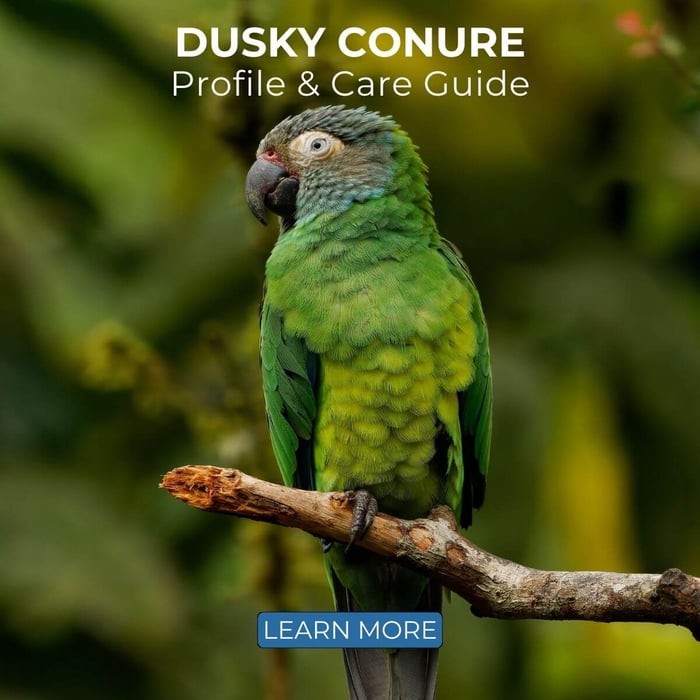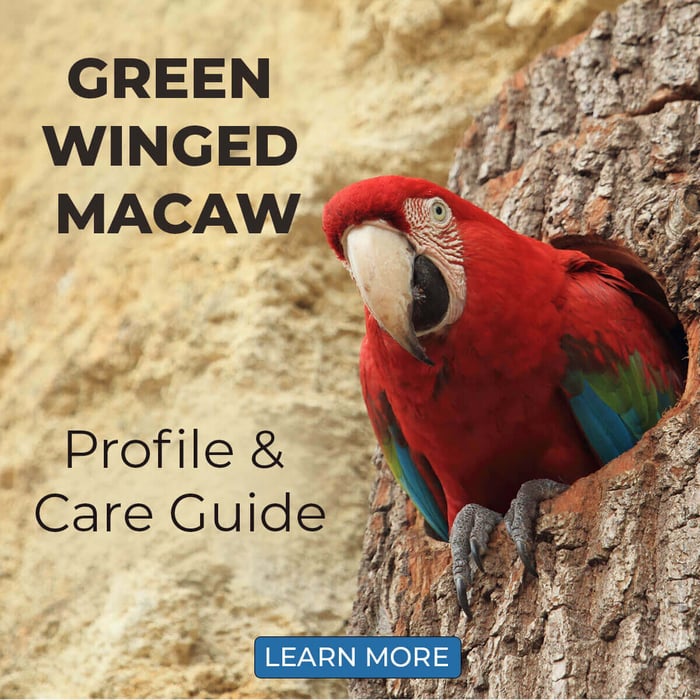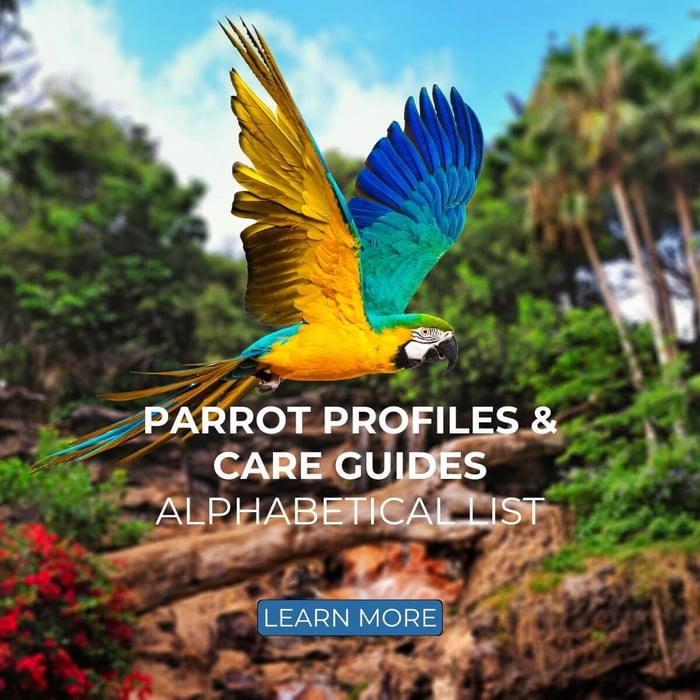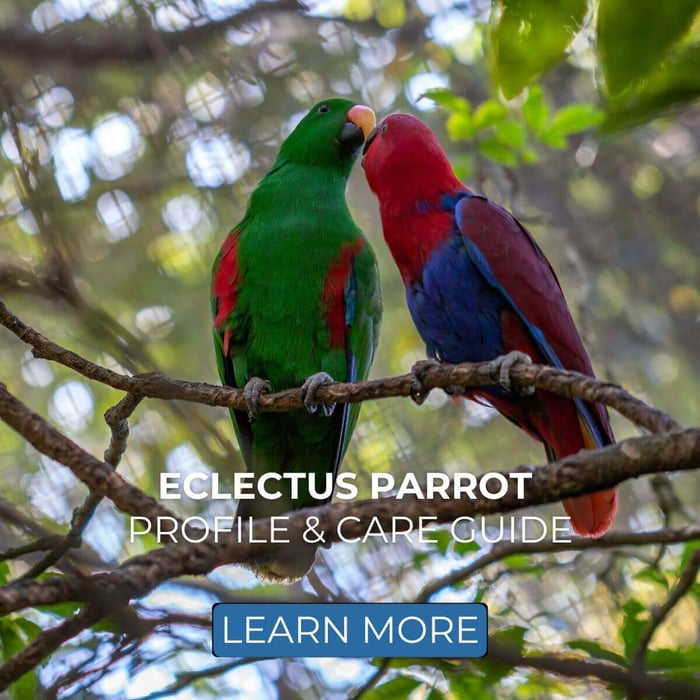Umbrella Cockatoo - Profile & Care Guide
| Common name: | Umbrella cockatoo, white cockatoo |
| Scientific name: | Cacatua alba |
| Length: | Up to 46 cm (18") |
| Weight: | Up to 700 grams |
| Lifespan: | 40+ years |
| Origin: | Indonesia |
| Noise level: | Extreme |
NATURAL HABITAT

The Umbrella Cockatoo is naturally found in Indonesia, specifically in the province of North Maluku. Here, the species inhabits a handful of tropical islands.
These cockatoos prefer lowland (up to 900 m) rainforest habitats. They will also pop up in mangroves, plantations, secondary forest, and anywhere else there are large trees for nesting.
UMBRELLA COCKATOO INTELLIGENCE & PERSONALITY
Like many other large parrot species, this cockatoos are stunningly intelligent. They possess incredible problem-solving skills and have great memories. In addition, they’re highly sociable. They can form a close bond with their human caretakers, though keep in mind that they can be “one-person birds” who have a clear favourite family member. You’ll never be bored with a U2 around!
Their ability to learn tricks and their often snuggly nature have made them quite popular despite their hefty price tags. However, it’s important to remember that it’s not all just fun and games. Large birds like these are not for first-time parrot owners, as they’re incredibly demanding. You should think twice before adopting. Consider: many parrots end up in animal shelters before they’re a few years old because their owners weren’t prepared to meet their needs.

Umbrella cockatoos need proper socialisation. Even then, they’re prone to behavioural issues (feather plucking, screaming even more than usual, aggression) if they’re left alone too much or allowed to become bored. They like spending pretty much all day with their owners, which can get exhausting. Additionally, chewing is a natural behaviour for them, and those large beaks can be highly destructive.
If you really want to learn to understand your cockatoo, their crest can help. These birds are highly expressive! When they’re excited or alert, they’ll raise their crest feathers, making them look even bigger than they already are. A partially raised crest is usually reserved for mildly interesting situations, while a flat crest means your bird is relaxed.
UMBRELLA COCKATOO NOISE LEVEL & TALKING ABILITY
Before we go into their talking ability, we’d like to emphasise something important. These are among the loudest parrots out there. Of course, it all depends on the individual, but umbrellas have the capacity to reach 90+ decibels with their screams—and they love hearing their own voices.
We don’t recommend these birds for apartment dwellers. They scream when they’re happy, when they want attention, when they want food when they hear loud noises in their environment, and even just because they can. Before you add one to your family, visit a breeder or someone you know who owns an umbrella cockatoo. This can help you get an idea of whether you can handle their noise level.
Now, on to the fun part: this cockatoos can definitely learn to talk. Their voices are not as clear as something like an African grey, but they are able to develop pretty good vocabularies. They also like imitating noises they hear in their environment. Dog owners might be surprised to find their parrot barking at them!
If you’d like to train your cockatoo’s talking abilities, repetition is key. Start with short words like the bird’s name, “hello”, “bye-bye”, and work your way up to more complicated phrases or tunes.
FEEDING & NUTRITION FOR YOUR UMBRELLA COCKATOO
Wild umbrella cockatoos feed on a variety of seeds, nuts, fruit, and berries. In your home, the ideal staple diet for your bird would consist of high-quality pellet food for large parrots, daily servings of fresh vegetables, and regular portions of fresh fruit. You can also feed a seed mix, but because dry seeds are high in fat and low in nutrients, they shouldn’t make up the bulk of a cockatoo’s meals.
Variety is the spice of life (and the key to a healthy bird). Be sure to regularly mix things up with snacks and treats like:
- Cooked grains or legumes like rice, whole-wheat pasta, and lentils
- Small amounts of protein, like boiled eggs or mealworms
- Sprouted seeds or legumes
- Pieces of nuts like walnuts and almonds (best as training treats only due to their fat content)
Because cockatoos get bored quickly, we highly recommend presenting food in a foraging setting as often as you can. Foraging toys, foraging boxes, and similar devices challenge your parrot to solve puzzles and work for its food. This also helps keep it active and reduces the risk of obesity, which is common in these pet birds.
Always keep fresh water available, preferably from multiple sources. Remove uneaten foods after a few hours to prevent spoilage, and clean water and food dishes daily to keep things hygienic.

HOUSING FOR YOUR UMBRELLA COCKATOO
A big bird needs a big home! Your cockatoo’s cage should be as big as you can fit in your home, with a minimum length of at least 1.25 m (50″) for a bird that gets a lot of out-of-cage time. If you’re planning on keeping your parrot inside its cage for most or all of the day, a full-sized indoor aviary is the best option. Remember, these are active birds that need to be able to stretch their wings!
A stainless steel cage is preferable. Make sure it’s sturdy enough to withstand the cockatoo’s strong beak and has a good locking mechanism. The bars should be close enough together to prevent the bird from sticking its head through them, as this can lead to injury.
Decorate the cage with a variety of natural wood perches, ladders, and platforms. Then, add a pile of toys: parrots are highly playful beings that love to chew, crunch, shred, preen, and make noise. Colourful toys for large parrots will help keep your bird entertained even during moments you’re not able to spend time with it. Rotate toys regularly to keep them fun and fresh – remove those that are destroyed.
Your cockatoo will ideally spend at least a few hours a day out of its cage. As such, it can be a good idea to set up a nice play area for it to hang out on top of the enclosure. Alternatively, you could install a big parrot tree on a wheeled platform so your bird can spend time with the family wherever they are in the house.
FEATHER PLUCKING IN UMBRELLA COCKATOOS
Unfortunately, feather plucking is a common issue in cockatoos. We’ve already discussed how important it is for these birds to receive enough mental stimulation and emotional engagement; this is one of the behavioural issues that can pop up if they don’t.
If your parrot appears to be overpreening or actively picking its feathers (or even its skin), you should consult your veterinarian. They will be able to rule out underlying medical causes—stress due to pain or discomfort can cause plucking—and help you figure out how to get your cockatoo back on track.
FACTS
- Unfortunately, the IUCN Red List considers Cacatua alba to be an Endangered species in its natural habitat. The population is under severe pressure, primarily from trapping for the pet trade, although habitat loss is also a major problem. Their numbers are declining rapidly.
- Like many other parrots, umbrella cockatoos have impressive lifespans. It’s not unusual for them to live for 40 years or longer. The oldest known individual was said to be Duster, who passed away at almost 100 years old at a Florida-based parrot rescue.
- Umbrella cockatoos have been kept as pets by humans for over 1000 years. In China, for example, their import began all the way back in the 3rd century. They were popular in poetry and art. Even some emperors favoured their company!
CONCLUSION
The umbrella cockatoo is one of the most fun and engaging parrots around. It’s also a huge handful, making it a suitable choice only for experienced and dedicated parrot enthusiasts. If you’re just starting out, maybe you’d like to keep a cockatiel instead.
To view other Parrot Profiles & Care Guides, visit our Alphabetical list of Parrot Fact Sheets by visiting https://parrotessentials.co.uk/blog/parrot-profiles-care-guides
Sources
Parr, M., & Juniper, T. (2010). Parrots: a guide to parrots of the world. Bloomsbury Publishing.




